Happy National Vinyl Record day! Today we’ll spin two tracks on vinyl every hour. Here’s 5 fun vinyl facts you should know!
1. 13 million vinyl records were sold in the U.S. in 2016. A lot of that can be attributed to the annual Record Store Day. When RSD was founded in 2007, there were less than 1 million vinyl albums sold in the U.S. In January 2017, Nielsen reported that there were 13 million vinyl albums sold in 2016 alone.
It was the best year ever for vinyl since Nielsen Music began tracking album sales in 1991. The best-selling vinyl albums in the U.S. were Twenty One Pilot’s Blurryface, David Bowie’s Blackstar and Adele’s 25.
2. Vinyl LP sales grew to over 11% of total physical album sales in 2016. This marks 11 years of year-over-year increases for vinyl LPs, reaching a record sales level in the Nielsen Music era (since 1991) with over 13 million sales this year.
3. A Billboard analysis shows that Amazon is the largest seller of vinyl in the U.S., with about 12.3% market share, followed by Urban Outfitters with 8.1% market share.
4. The history of the date began not on the date when the Vinyl record company decided to create a date, but when the first phonograph was invented. It happened in 1877. The inventor was Thomas Edison. Though, the holiday took the day of the invention for itself, the first notice of the sound recordings concerns 1857. Leon Scott patented the phonautograph. These recordings of sound are the earliest ones.
The phonograph was an invention which could record the sound and reproduce it. In the 1880s the producers made it possible to sell the equipment due to the wax phonograph cylinder. In the late 80s of the 19th century in Europe special discs were sold. They were invented by E. Berliner. The man proposed to play them with a hand-propelled machine.
5. Turntables can track color vinyl differently than black vinyl, and some people report skips on color record copies which do not happen on the same record if pressed on black vinyl (typically on lower-end turntables). Some people say the music itself can sound slightly different on color vinyl versions versus black vinyl versions of the same record. However, since the grooves are the same, this likely has more to do with the type of turntable or cartridge being used. Standard black vinyl is the quietest in terms of surface noise, followed by transparent colors and opaque colored vinyl. Random (recycled) color shades, split or splattered, glow in the dark, and glitter records are comparatively much noisier.













